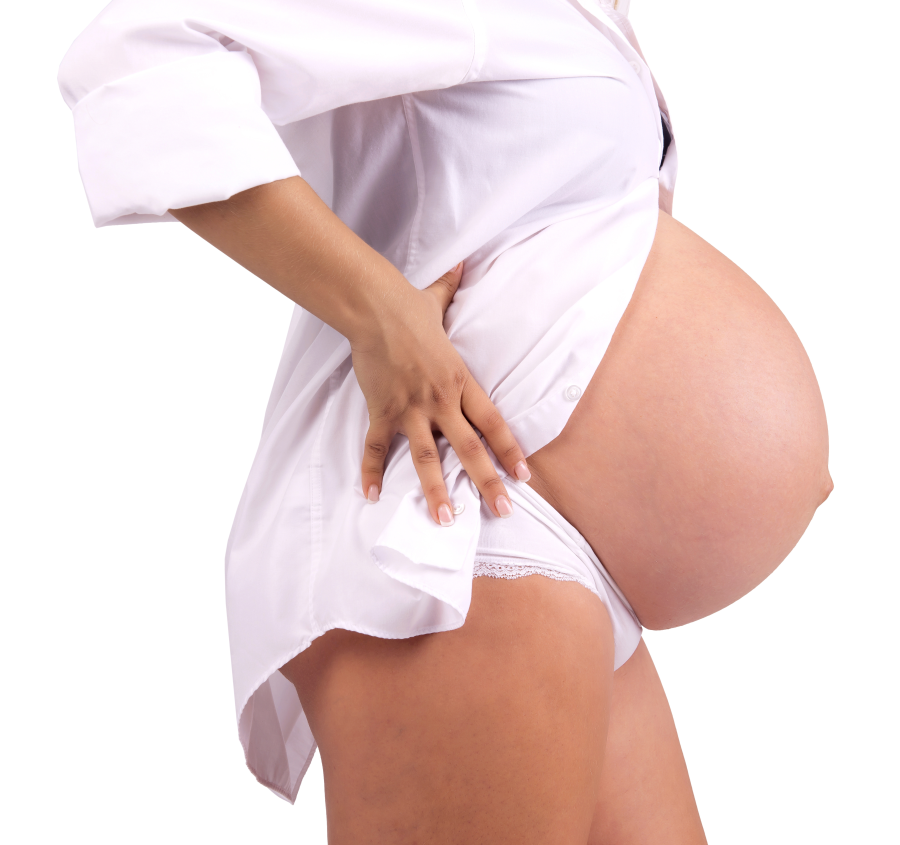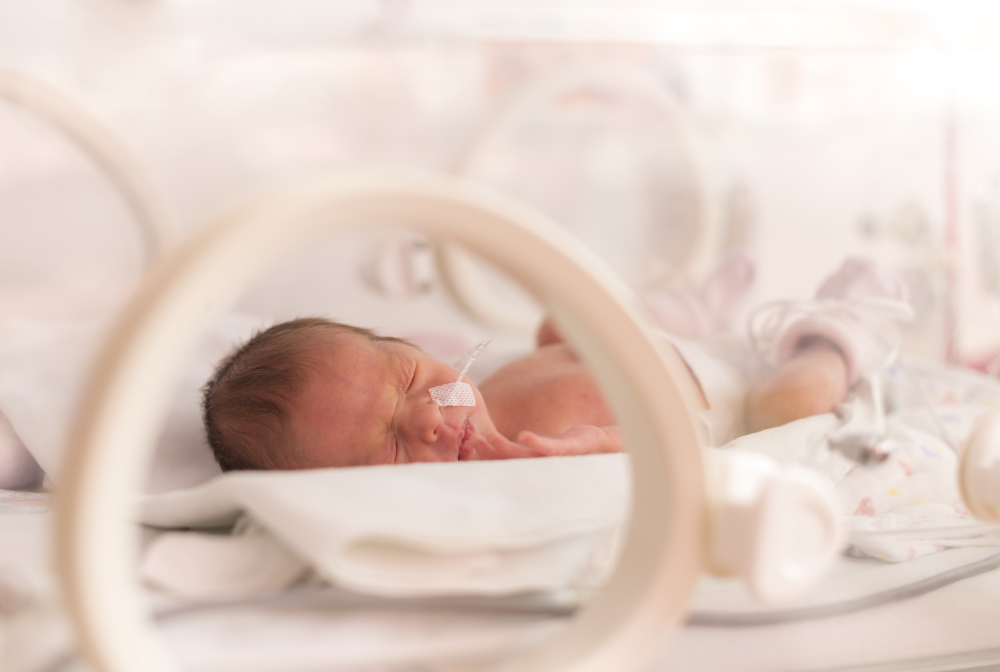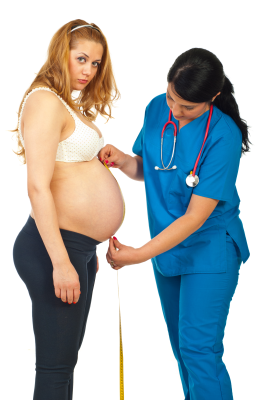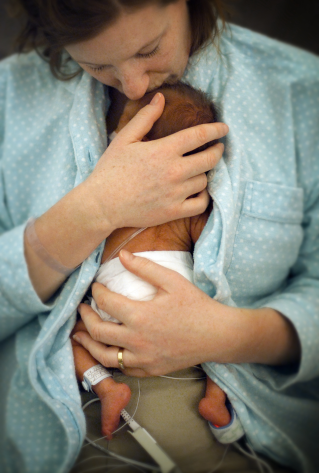Second Trimester Twin Pregnancy Complications

To continue, we'll be covering second trimester twin pregnancy complications in part two of this series...
Second Trimester Twin Pregnancy Complications and What to Expect
It's fairly obvious that if you're carrying multiples, you're likely to look pregnant (and not just several donuts too many) sooner. Unfortunately for those of us that like to keep such things under our hats until safely well into the second trimester, this makes a daily wardrobe of baggy jumpers a must.
I don't think I even GOT to the second trimester before a nosey-parker
at work cornered me in an office, late on a Friday (in case she was
wrong and therefore I'd have the weekend to get over the insult) and
asked the dreaded "Are you pregnant?". I briefly considered stammering a
bad lie, or an even more bold-faced "No, why?" in the hope that the
shame of calling me fat, even indirectly, would forestall further
questioning along this line but the thought of being proven a rather
obvious liar in the coming months dictated honesty.
Being pregnant after IVF and a loss is nerve-wracking. That "yes" was
scarier that the thought of parachuting from a jumbo-jet mid-flight. I
was outed. I think the moral of the story is that if somebody hasn't
told you that they're pregnant, unless they're actually giving birth at
the time, you should probably wait for them to offer that information!
Regardless of knocked-up etiquette, I looked silly.
Courtesy of my more customary scrawny beanpole-ness, I looked quite
ridiculously like a snake that swallowed a watermelon. My "baby bump"
was going to turn into more of a mountain range.
To be more scientific about it, I measured 20 weeks in fundal height at a
mere 13. I continued to measure exceedingly ahead, such that I measured
term size at 28 weeks (the start of the third trimester). My final
measurement was 50cm. My "waist" was an eye-wateringly uncomfortable 52
inches. That's not uncommon for twins.
The Science:
Fundal height is a measurement usually taken at each obstetric visit
that runs from the top of the pubic bone (symphysis pubis) to the top of
the uterus. It gives a rough idea as to how the pregnancy is going,
running on the assumption that if the size of the uterus is growing, the
baby is probably growing too.
It is normally measured in centimeters, because of a bit of biological
luck that means the normal height of the fundus in cm equals the weeks
of gestation (plus or minus a couple of cm) from about 20 weeks onwards.
Of course, in a multiple pregnancy where there is more than one baby in
the uterus this measurement is less helpful for two reasons:
Firstly, you will inevitably measure ahead- theres twice as much baby
in there!
Secondly, one baby can be growing well and one not so well, and the tape
measure will still show growth. It cant differentiate.
This is the reason that multiple pregnancies often have monthly
(sometimes more often depending on the type of twin pregnancy) growth
scans to check on each baby individually, especially in the third
trimester even if all is going well.
Other things that may happen in the second trimester, depending on your pregnancy and your caregiver:
More frequent visits.
Checks of your cervical length. This can be either manual (by vaginal
examination) or with ultrasound (a more accurate method, especially if
with a transvaginal approach). Since approximately half of twins will be
premature, and it is hard to predict who will deliver prematurely and
who is more likely to go to term, much effort has gone into finding ways
to identify those at greater risk. Cervical length is one method, but
it is not absolute. Having a shorter cervix to start with, early or
rapid shortening of the cervix is a known risk factor for preterm
delivery, but doesnt mean it is inevitable. However, checking this can
help identify women who are at increased risk of having their twins
prematurely and allow closer monitoring.
Ultrasounds. Apart from the scans related to looking for abnormalities
in your babies, commonly performed at 12 and 18-20 weeks of pregnancy
(if you choose to screen for Down Syndrome and other conditions), you
may have additional growth scans in the second trimester, especially if
you have mono-chorionic twins as there are special risks with mo/di and
mo/mo twins. Whatever type of twin pregnancy you have, by the third
trimester you are likely to be having at least monthly growth scans. You
will likely be lucky enough to see your babies on ultrasound many times
before theyre born, often down to the shape of the nose, hair and
thumb sucking.
If you have monoamniotic twins (mo/mo, or MCMA), you may be admitted to
hospital later in the second trimester for closer monitoring of the
babies.
Then I began noticing that the relatively-painless Braxton-Hicks
contractions that had plagued me since the end of the first trimester on
and off (usually annoying me by interrupting my sleep) were happening
kind of often and were getting increasingly uncomfortable.
Hmm.
It turns out that I was now the owner of a uterus that liked contracting
every ten minutes in runs of several hours long, often more than once a
day. My uterus, like the rest of me, was officially dubbed rather
irritable.
(a brief digression- there is natural variation in the inherent tendency of our uteruses to contract in pregnancy. Some women have very quiet uteruses, and dont have many Braxton Hicks, or only late. Some, like me, contract early and often. Women with more active uteruses do tend to deliver earlier, on the whole, but again it is not inevitable. Its just another risk factor when it comes to premature delivery.)
Fixing the traditional provokers of uterine irritability like dehydration and excessive activity didn't help. I drank until I had to pee non-stop. No dice. I wasn't quite twenty weeks pregnant, but my uterus was not unreasonably protesting about the additional load. I had to leave work. I was benched for the duration.
Second Trimester Twin Pregnancy
Complications and Preterm Labor

The Science:
Treating Early Contractions
Premature labor comes in two major varieties, threatened and actual. The difference between the two is that actual premature labor is defined as uterine contractions causing cervical effacement and dilation. Threatened premature labor implies contractions without cervical change.
Medications can be given to help halt early contractions, and are especially useful in that they may allow a woman who is at risk of delivering very prematurely to be transported to a hospital with a high-level NICU and allow sufficient time for steroids to be given to help mature the babies lungs. There are several options, and several medications may be trialed to find the most effective for a given situation:
Nifedipine (also known as Procardia). This medication has
the advantages of being available as a tablet and not requiring
injections or a IV. It is a newer medication in the treatment of early
contractions, and there is some evidence it may be better tolerated by
the mother and associated with slightly better outcomes for the baby.
The more common side effects are low blood pressure (it is more commonly
used as a treatment for high blood pressure) and swelling of the
ankles.
Terbutaline. This drug requires injection. It may make you feel a bit shaky and your heart may feel as if it is racing (palpitations).
Indomethacin. This is a type of drug known as a non steroidal
anti inflammatory (NSAID). It is usually only used in the short term
because of side effects on the babies if used for longer periods.
GTN. An angina medication in its more common use, GTN will
occasionally be trialled. The major side effects are low blood pressure
and headaches.
Magnesium Sulphate. This medication requires an IV infusion, and is used in hospital, often when other drugs are not effective.
Progesterone. There is research showing that in women with
singleton pregnancies who have had a premature birth previously,
progesterone will reduce the risk of this happening again (recurrence).
Evidence is now coming out that progesterone may be useful in multiple
pregnancies, too.
I was started on nifedipine, but continued to contract un-merrily away,
increasingly uncomfortably (until the point that I was constantly trying
to go to the loo, to relieve the pressure in my pelvis, overall a
rather un-fun situation). We tried some other medications, but they were
even worse.
Over time, stability was achieved with increased nifedipine and the
addition of progesterone. Together they held my misbehaving uterus at
bay, although I was till contracting, my cervix stopped shortening and I
could at least get some sleep at night, apart from the legion of trips
to wee, anyway.
Simply put, weeks 20-28 weeks were scary. I had several risk factors for premature delivery (a contracting uterus, a shortening cervix and multiple babies) and the realities of extreme prematurity are terrifying.
I was lucky. We did prophylactic steroids twice, but I didn't deliver.
The Science:
Prematurity and Twins - A Bit More...
Term is normally considered to be 40 weeks of completed pregnancy with a
range of 37-42 weeks allowed as normal, so by definition less than 37
weeks is premature, and over 42 is postmature. The reason that attention
is paid to these dates is that mortality (death) and morbidity
(illness) are higher the further on departs from the normal gestation
length .
In twins, 38 weeks is considered full term.
Even if term, twins are often smaller than single babies born at the
same gestation as the uterus may not be able to supply two growing
babies completely. This tendency to lower birth weight may also compound
the effect of prematurity, as larger babies at a given gestation tend
to do better than those of smaller birth weight.
Premature birth is taken quite seriously, because despite significant
technological advances in the care of premature infants, there is still a
significant rate of complications in babies born very premature both in
the short and longer terms. Prematurity is also often a significant
health expenditure in many countries.
The major trigger of prematurity in multiples is uterine ovredistension.
The more babies, the more likely they are to be premature, and the
earlier they will be born on average.
Around half of all twins will be premature, the average birth being at 36 weeks gestation. Around ten percent of twins will be born sooner than 32 weeks, some of which will be born very premature (before 28 weeks).

Prematurity is commonly divided up into mildly premature (less than 36
but more than 32 weeks), moderately premature (32-28 weeks) and very
premature (less than 28 weeks). Extremely premature infants born in the
weeks of viability (24-26 weeks) do have a high mortality rate, very
sadly.
The earlier a baby is born, the greater risk of complications and the
longer they are likely to need to spend in hospital. Broadly speaking,
minorly premature infants may have some difficulty regulating their body
temperature and blood sugars initially due to small size and are likely
to need tube feeding for some of their nutrition until they grow bigger
and stronger. They may occasionally have some trouble with breathing,
but usually will only require CPAP (a non-invasive breathing support).
More moderately premature infants are likely to spend time in a
humidi-crib, require tube feeding for longer and may need to spend some
time on a ventilator to help their breathing, especially if there has
not been time for steroids to be given to help mature the lungs before
birth.
Very premature infants will need extensive help to keep warm, hydrated,
fed and breathe and are likely to spend a long period of time in
hospital.
Although most twins are born at or near term, and I personally find it
hard to talk about the scary things that can happen when babies are born
very early, I think it is also important to be honest and not gloss
over it excessively. Babies that do come very early have risks of
serious health complications including bleeding into the brain, severe
infection and difficulty with their breathing, even with the aid of
breathing machines. Some do pass away because of these and other
complications. If they survive, they are at increased risk of long term
disability. If you are in the situation where your twins are born very
early, it is likely to be a very scary and emotionally intense time.
Please seek support.
Next up, Third Trimester Twin Pregnancy Complications...

Recent Articles
-
Double Duty Log Book For Twins - An easy way to keep track
Apr 11, 24 06:18 PM
Our Double Duty Log Book for Twins will help you stay on schedule, keep track of feedings and more. Save your sanity and get it all done with a twin log sheet that really works! -
37 weeks+4days and feeling huge
Sep 14, 23 12:12 PM
I am expecting a boy and girl.❤️ My belly is massive,it’s 3 times bigger than my previous pregnancy.My bum has also gotten bigger(My hubby loves it)!I -
Foods Babies Should Avoid
Jan 12, 23 06:30 PM
Foods Babies Should Avoid is a part of our feeding twins guide






Comments or Questions?
Join the conversation. We love to hear from our readers!